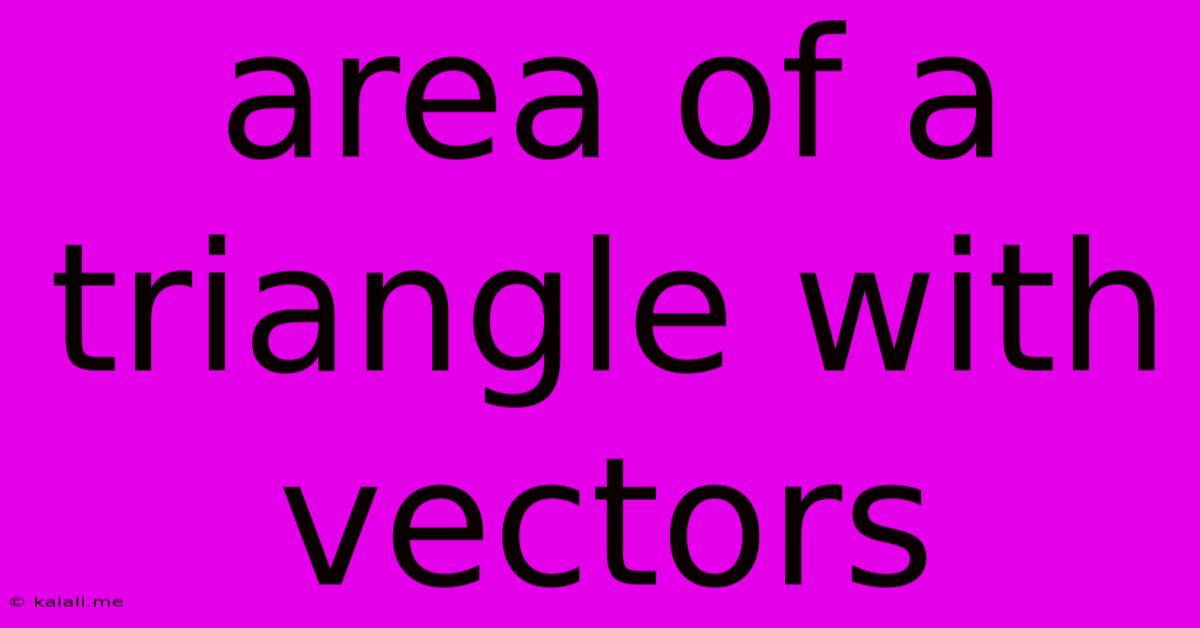Area Of A Triangle With Vectors
Kalali
May 21, 2025 · 3 min read

Table of Contents
Calculating the Area of a Triangle Using Vectors: A Comprehensive Guide
Meta Description: Learn how to efficiently calculate the area of a triangle using vectors. This guide provides a clear explanation of the method, including examples and helpful visualizations. Master this essential vector application for geometry and physics problems.
Determining the area of a triangle is a fundamental concept in geometry. While the traditional formula (1/2 * base * height) works well for right-angled triangles and those where the height is easily determined, it becomes less straightforward for other triangle types. Vector mathematics offers a powerful and elegant alternative, especially useful when dealing with coordinates in two or three-dimensional space. This method simplifies calculations and provides a more general approach.
Understanding the Vector Approach
The area of a triangle formed by vectors a and b is directly related to the magnitude of their cross product. The cross product, denoted by a x b, is a vector perpendicular to both a and b. Its magnitude represents the area of the parallelogram formed by these two vectors. Since a triangle is half a parallelogram, we can easily derive the area of the triangle.
Formula and Calculation
The formula for the area of a triangle using vectors is:
Area = (1/2) ||a x b||
where:
- a and b are vectors representing two sides of the triangle that share a common vertex.
- a x b denotes the cross product of vectors a and b.
- ||a x b|| represents the magnitude (length) of the cross product vector.
The cross product itself is calculated as follows (for three-dimensional vectors):
a x b = (a₂b₃ - a₃b₂)i + (a₃b₁ - a₁b₃)j + (a₁b₂ - a₂b₁)k
Where:
- a = a₁i + a₂j + a₃k
- b = b₁i + b₂j + b₃k
- i, j, and k are the unit vectors along the x, y, and z axes respectively.
The magnitude of the cross product is then calculated using the Pythagorean theorem in three dimensions:
||a x b|| = √((a₂b₃ - a₃b₂) ² + (a₃b₁ - a₁b₃) ² + (a₁b₂ - a₂b₁) ²)
For two-dimensional vectors (in the xy-plane), the calculation simplifies significantly. The area is given by the absolute value of the determinant:
Area = (1/2) |a₁b₂ - a₂b₁|
Examples
Let's illustrate with a few examples:
Example 1 (2D):
Consider a triangle with vertices A(1, 2), B(4, 3), and C(2, 5). We can define vectors a and b as follows:
- a = B - A = (4-1, 3-2) = (3, 1)
- b = C - A = (2-1, 5-2) = (1, 3)
Using the 2D formula:
Area = (1/2) |(33) - (11)| = (1/2) |9 - 1| = 4 square units
Example 2 (3D):
Consider a triangle with vertices A(1, 0, 2), B(3, 1, 0), and C(0, 2, 1). Vectors a and b are:
- a = B - A = (2, 1, -2)
- b = C - A = (-1, 2, -1)
Calculating the cross product:
a x b = (1*-1 - (-2)2)i + ((-2)(-1) - 2*-1)j + (22 - 1-1)k = 3i + 4j + 5k
The magnitude is:
||a x b|| = √(3² + 4² + 5²) = √50
Therefore, the area is:
Area = (1/2)√50 ≈ 3.54 square units
Applications
This vector method for calculating triangle areas finds extensive application in various fields:
- Computer Graphics: Determining areas of polygons for rendering and collision detection.
- Physics: Calculating work done by forces and other related quantities.
- Engineering: Solving problems in structural analysis and mechanics.
- Mathematics: Solving geometric problems and proving theorems.
This comprehensive guide provides a thorough understanding of calculating triangle areas using vectors. By mastering this technique, you’ll enhance your problem-solving skills in diverse mathematical and scientific contexts. Remember to always carefully define your vectors based on the chosen vertices to ensure accurate results.
Latest Posts
Latest Posts
-
Prevent An Expressway Emergency By Merging Without
Jul 12, 2025
-
How Many Grams Of Sugar In A Pound
Jul 12, 2025
-
7am To 11am Is How Many Hours
Jul 12, 2025
-
If Your 35 What Year Was You Born
Jul 12, 2025
-
How Many Cups Is 1 Pound Of Cheese
Jul 12, 2025
Related Post
Thank you for visiting our website which covers about Area Of A Triangle With Vectors . We hope the information provided has been useful to you. Feel free to contact us if you have any questions or need further assistance. See you next time and don't miss to bookmark.